ITC506 Early Launch Scenario: Doing Ethics Technique Assignment
VerifiedAdded on 2021/04/21
|7
|2086
|33
Homework Assignment
AI Summary
This assignment analyzes an ethical dilemma presented in an early product launch scenario. The case involves a project manager facing pressure from a program director to launch a software product one month ahead of schedule, despite the product lacking encryption and proper testing. The project manager is threatened with job loss and even offered a bribe. The analysis, conducted using the 'Doing Ethics Technique,' addresses questions about what's going on, the facts, the issues, affected parties, ethical implications, potential solutions, and the best course of action. The assignment emphasizes the importance of ethical decision-making, highlighting the risks of data breaches, the unethical nature of bribery, and the significance of adhering to project schedules to ensure product quality and maintain ethical standards within the company. The project manager's refusal to compromise on ethics is presented as the correct approach, prioritizing client data security and the company's reputation.
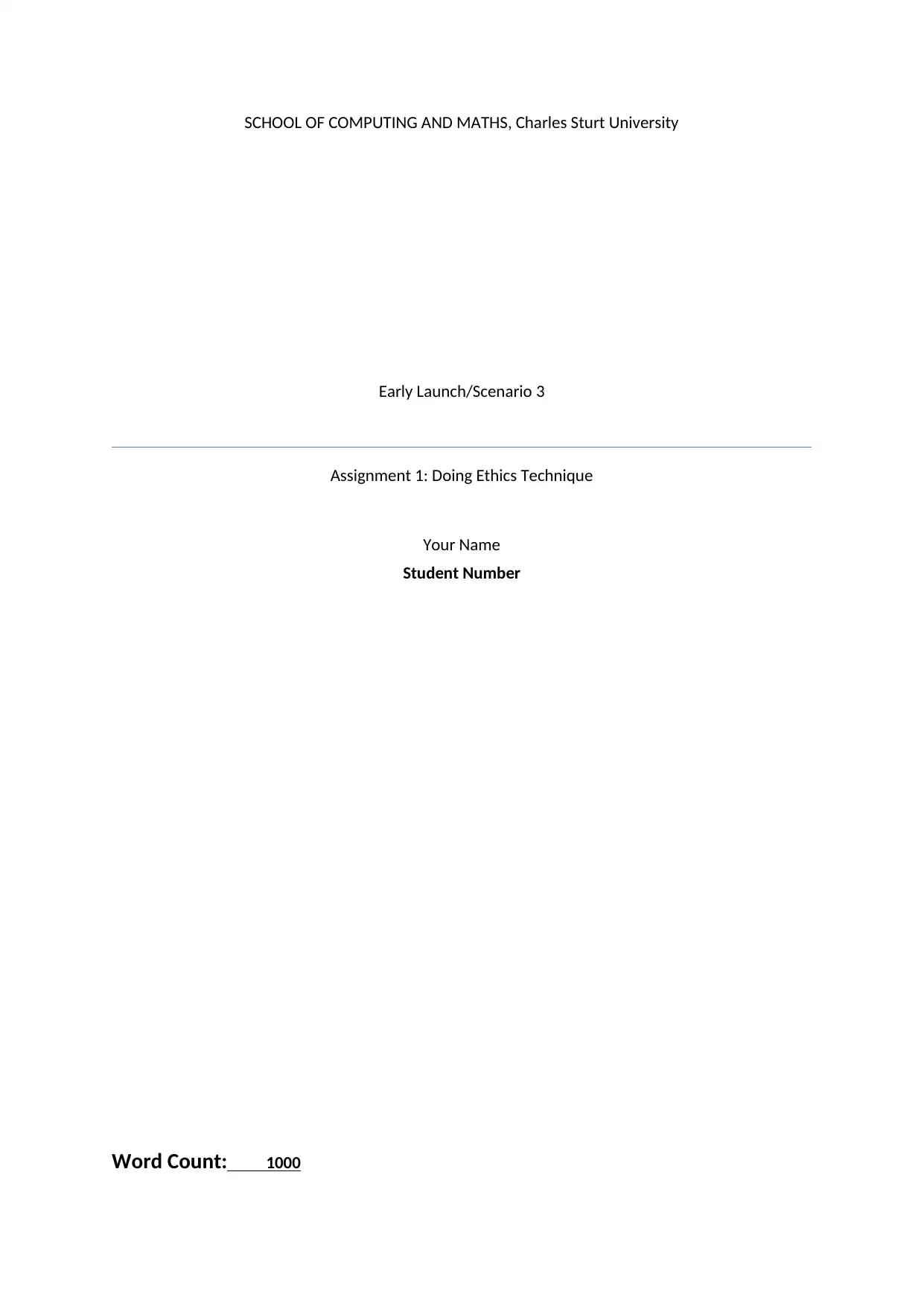
SCHOOL OF COMPUTING AND MATHS, Charles Sturt University
Early Launch/Scenario 3
Assignment 1: Doing Ethics Technique
Your Name
Student Number
Word Count: 1000
Early Launch/Scenario 3
Assignment 1: Doing Ethics Technique
Your Name
Student Number
Word Count: 1000
Paraphrase This Document
Need a fresh take? Get an instant paraphrase of this document with our AI Paraphraser
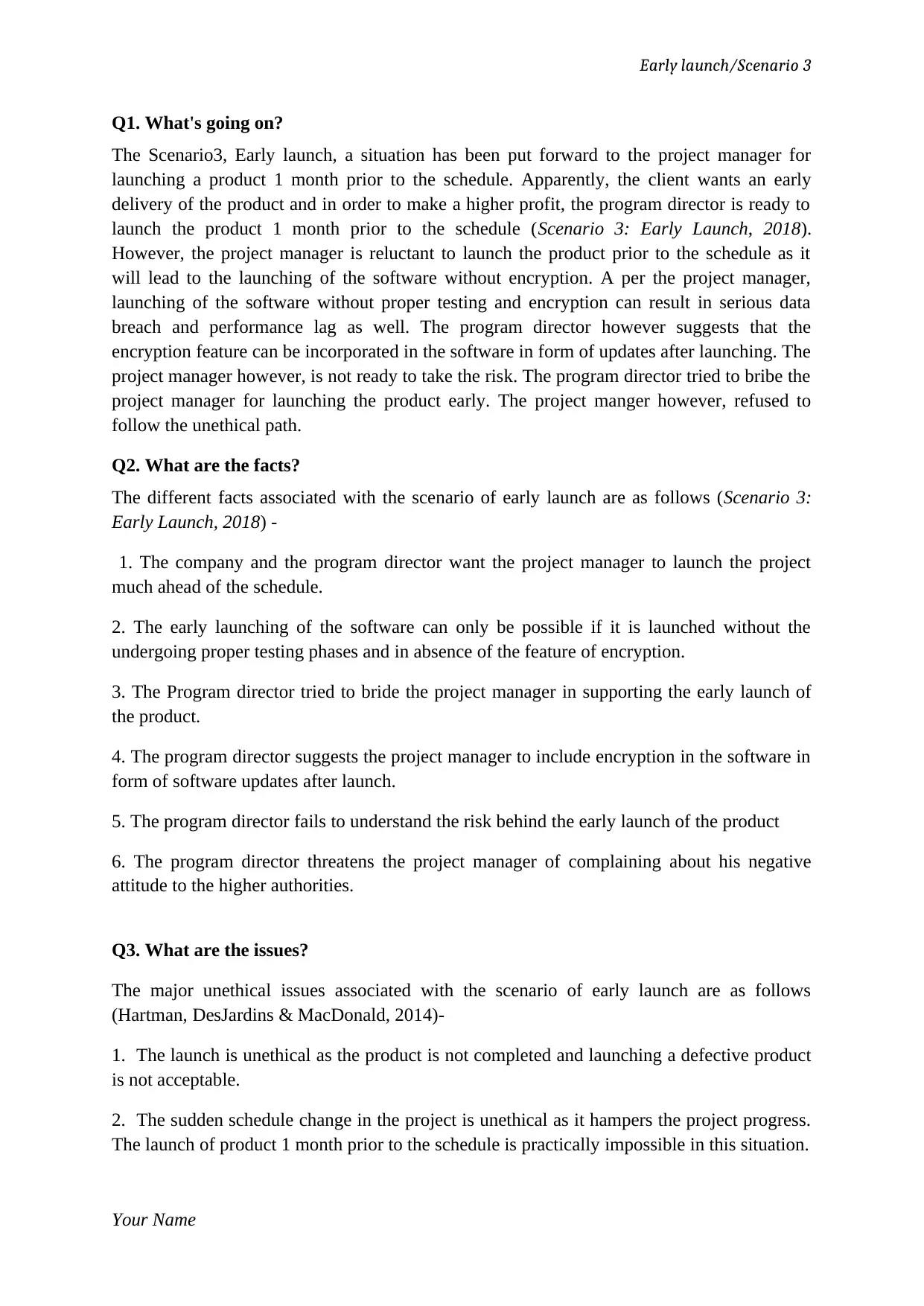
Early launch/Scenario 3
Q1. What's going on?
The Scenario3, Early launch, a situation has been put forward to the project manager for
launching a product 1 month prior to the schedule. Apparently, the client wants an early
delivery of the product and in order to make a higher profit, the program director is ready to
launch the product 1 month prior to the schedule (Scenario 3: Early Launch, 2018).
However, the project manager is reluctant to launch the product prior to the schedule as it
will lead to the launching of the software without encryption. A per the project manager,
launching of the software without proper testing and encryption can result in serious data
breach and performance lag as well. The program director however suggests that the
encryption feature can be incorporated in the software in form of updates after launching. The
project manager however, is not ready to take the risk. The program director tried to bribe the
project manager for launching the product early. The project manger however, refused to
follow the unethical path.
Q2. What are the facts?
The different facts associated with the scenario of early launch are as follows (Scenario 3:
Early Launch, 2018) -
1. The company and the program director want the project manager to launch the project
much ahead of the schedule.
2. The early launching of the software can only be possible if it is launched without the
undergoing proper testing phases and in absence of the feature of encryption.
3. The Program director tried to bride the project manager in supporting the early launch of
the product.
4. The program director suggests the project manager to include encryption in the software in
form of software updates after launch.
5. The program director fails to understand the risk behind the early launch of the product
6. The program director threatens the project manager of complaining about his negative
attitude to the higher authorities.
Q3. What are the issues?
The major unethical issues associated with the scenario of early launch are as follows
(Hartman, DesJardins & MacDonald, 2014)-
1. The launch is unethical as the product is not completed and launching a defective product
is not acceptable.
2. The sudden schedule change in the project is unethical as it hampers the project progress.
The launch of product 1 month prior to the schedule is practically impossible in this situation.
Your Name
Q1. What's going on?
The Scenario3, Early launch, a situation has been put forward to the project manager for
launching a product 1 month prior to the schedule. Apparently, the client wants an early
delivery of the product and in order to make a higher profit, the program director is ready to
launch the product 1 month prior to the schedule (Scenario 3: Early Launch, 2018).
However, the project manager is reluctant to launch the product prior to the schedule as it
will lead to the launching of the software without encryption. A per the project manager,
launching of the software without proper testing and encryption can result in serious data
breach and performance lag as well. The program director however suggests that the
encryption feature can be incorporated in the software in form of updates after launching. The
project manager however, is not ready to take the risk. The program director tried to bribe the
project manager for launching the product early. The project manger however, refused to
follow the unethical path.
Q2. What are the facts?
The different facts associated with the scenario of early launch are as follows (Scenario 3:
Early Launch, 2018) -
1. The company and the program director want the project manager to launch the project
much ahead of the schedule.
2. The early launching of the software can only be possible if it is launched without the
undergoing proper testing phases and in absence of the feature of encryption.
3. The Program director tried to bride the project manager in supporting the early launch of
the product.
4. The program director suggests the project manager to include encryption in the software in
form of software updates after launch.
5. The program director fails to understand the risk behind the early launch of the product
6. The program director threatens the project manager of complaining about his negative
attitude to the higher authorities.
Q3. What are the issues?
The major unethical issues associated with the scenario of early launch are as follows
(Hartman, DesJardins & MacDonald, 2014)-
1. The launch is unethical as the product is not completed and launching a defective product
is not acceptable.
2. The sudden schedule change in the project is unethical as it hampers the project progress.
The launch of product 1 month prior to the schedule is practically impossible in this situation.
Your Name
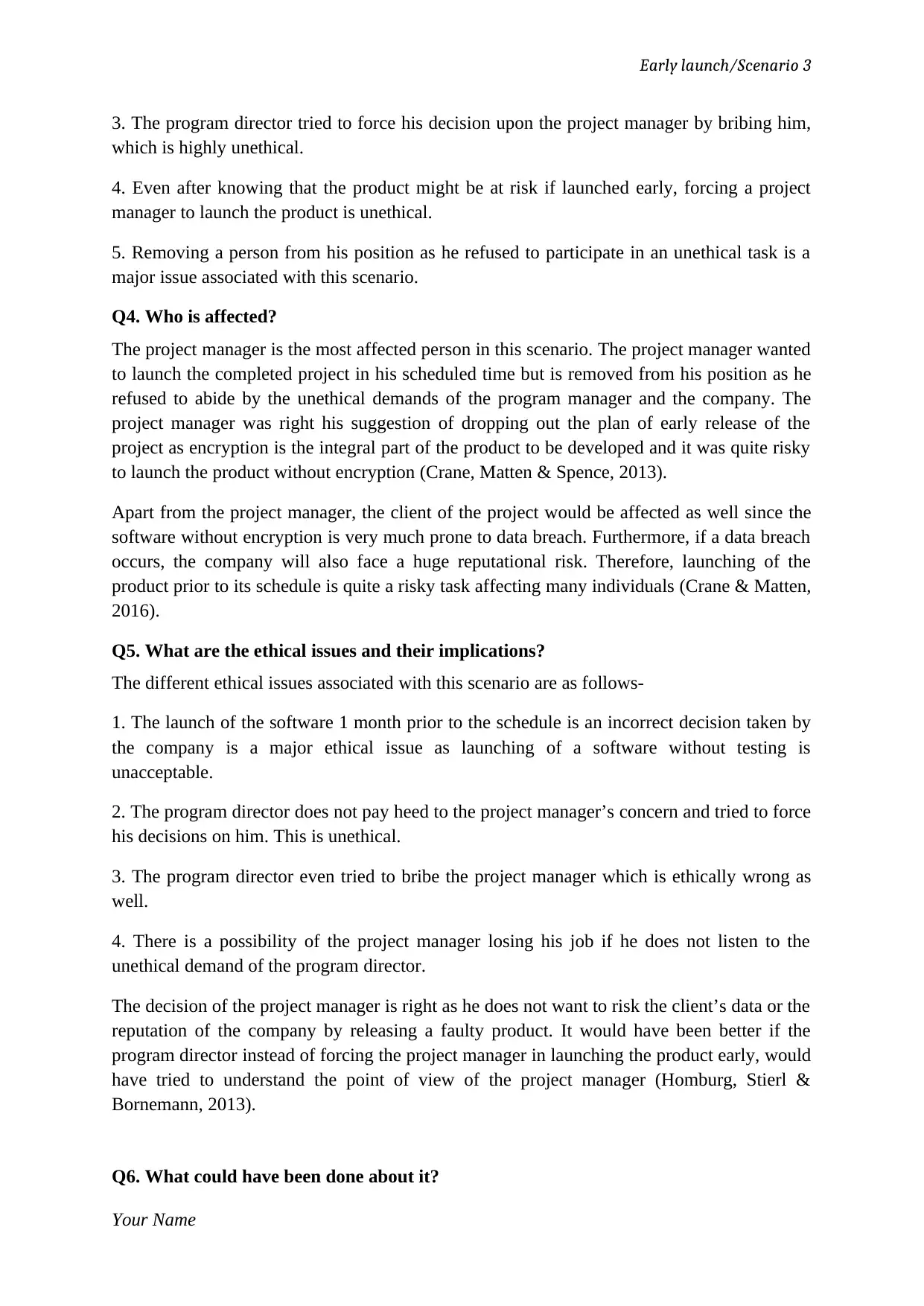
Early launch/Scenario 3
3. The program director tried to force his decision upon the project manager by bribing him,
which is highly unethical.
4. Even after knowing that the product might be at risk if launched early, forcing a project
manager to launch the product is unethical.
5. Removing a person from his position as he refused to participate in an unethical task is a
major issue associated with this scenario.
Q4. Who is affected?
The project manager is the most affected person in this scenario. The project manager wanted
to launch the completed project in his scheduled time but is removed from his position as he
refused to abide by the unethical demands of the program manager and the company. The
project manager was right his suggestion of dropping out the plan of early release of the
project as encryption is the integral part of the product to be developed and it was quite risky
to launch the product without encryption (Crane, Matten & Spence, 2013).
Apart from the project manager, the client of the project would be affected as well since the
software without encryption is very much prone to data breach. Furthermore, if a data breach
occurs, the company will also face a huge reputational risk. Therefore, launching of the
product prior to its schedule is quite a risky task affecting many individuals (Crane & Matten,
2016).
Q5. What are the ethical issues and their implications?
The different ethical issues associated with this scenario are as follows-
1. The launch of the software 1 month prior to the schedule is an incorrect decision taken by
the company is a major ethical issue as launching of a software without testing is
unacceptable.
2. The program director does not pay heed to the project manager’s concern and tried to force
his decisions on him. This is unethical.
3. The program director even tried to bribe the project manager which is ethically wrong as
well.
4. There is a possibility of the project manager losing his job if he does not listen to the
unethical demand of the program director.
The decision of the project manager is right as he does not want to risk the client’s data or the
reputation of the company by releasing a faulty product. It would have been better if the
program director instead of forcing the project manager in launching the product early, would
have tried to understand the point of view of the project manager (Homburg, Stierl &
Bornemann, 2013).
Q6. What could have been done about it?
Your Name
3. The program director tried to force his decision upon the project manager by bribing him,
which is highly unethical.
4. Even after knowing that the product might be at risk if launched early, forcing a project
manager to launch the product is unethical.
5. Removing a person from his position as he refused to participate in an unethical task is a
major issue associated with this scenario.
Q4. Who is affected?
The project manager is the most affected person in this scenario. The project manager wanted
to launch the completed project in his scheduled time but is removed from his position as he
refused to abide by the unethical demands of the program manager and the company. The
project manager was right his suggestion of dropping out the plan of early release of the
project as encryption is the integral part of the product to be developed and it was quite risky
to launch the product without encryption (Crane, Matten & Spence, 2013).
Apart from the project manager, the client of the project would be affected as well since the
software without encryption is very much prone to data breach. Furthermore, if a data breach
occurs, the company will also face a huge reputational risk. Therefore, launching of the
product prior to its schedule is quite a risky task affecting many individuals (Crane & Matten,
2016).
Q5. What are the ethical issues and their implications?
The different ethical issues associated with this scenario are as follows-
1. The launch of the software 1 month prior to the schedule is an incorrect decision taken by
the company is a major ethical issue as launching of a software without testing is
unacceptable.
2. The program director does not pay heed to the project manager’s concern and tried to force
his decisions on him. This is unethical.
3. The program director even tried to bribe the project manager which is ethically wrong as
well.
4. There is a possibility of the project manager losing his job if he does not listen to the
unethical demand of the program director.
The decision of the project manager is right as he does not want to risk the client’s data or the
reputation of the company by releasing a faulty product. It would have been better if the
program director instead of forcing the project manager in launching the product early, would
have tried to understand the point of view of the project manager (Homburg, Stierl &
Bornemann, 2013).
Q6. What could have been done about it?
Your Name
⊘ This is a preview!⊘
Do you want full access?
Subscribe today to unlock all pages.

Trusted by 1+ million students worldwide
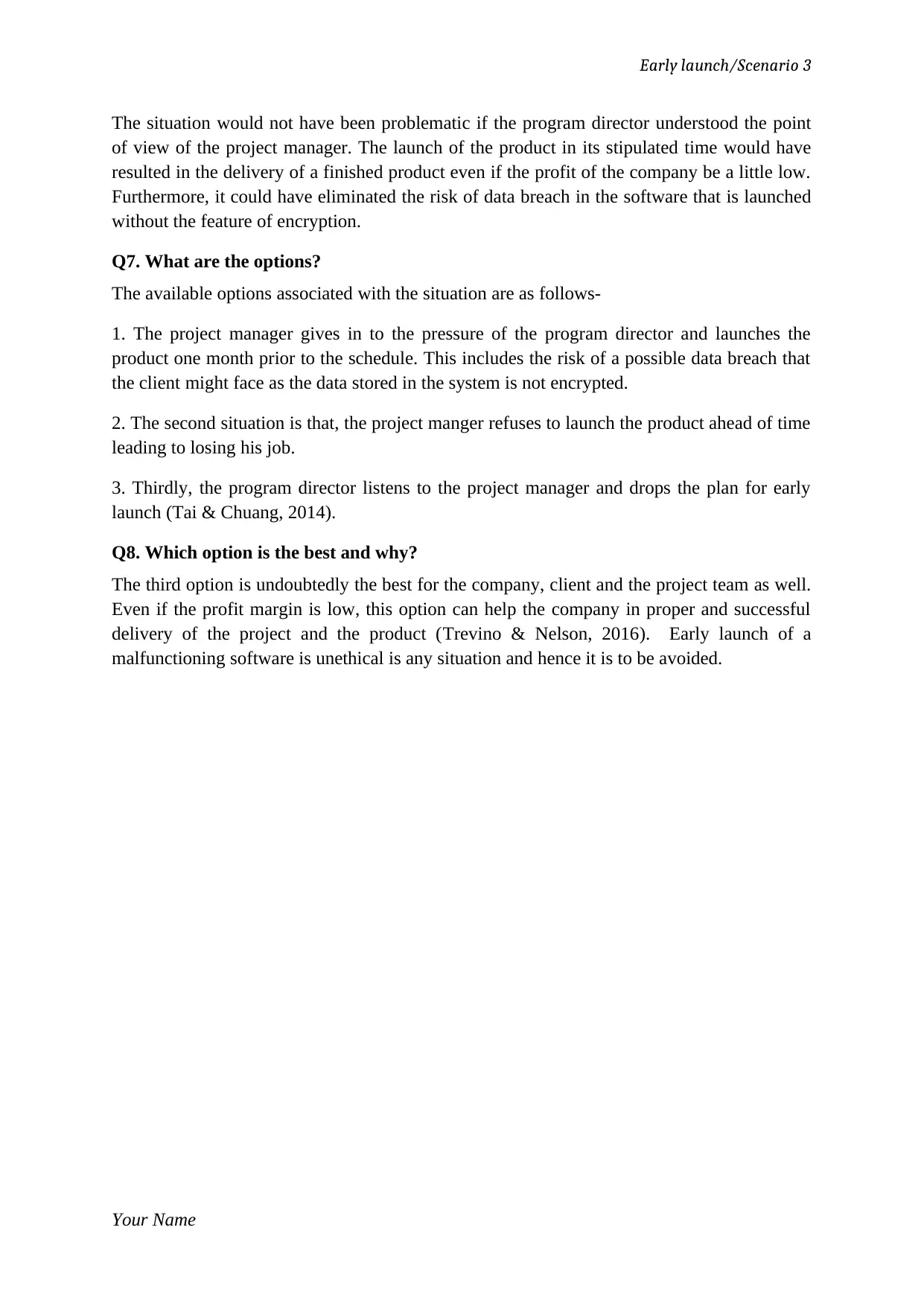
Early launch/Scenario 3
The situation would not have been problematic if the program director understood the point
of view of the project manager. The launch of the product in its stipulated time would have
resulted in the delivery of a finished product even if the profit of the company be a little low.
Furthermore, it could have eliminated the risk of data breach in the software that is launched
without the feature of encryption.
Q7. What are the options?
The available options associated with the situation are as follows-
1. The project manager gives in to the pressure of the program director and launches the
product one month prior to the schedule. This includes the risk of a possible data breach that
the client might face as the data stored in the system is not encrypted.
2. The second situation is that, the project manger refuses to launch the product ahead of time
leading to losing his job.
3. Thirdly, the program director listens to the project manager and drops the plan for early
launch (Tai & Chuang, 2014).
Q8. Which option is the best and why?
The third option is undoubtedly the best for the company, client and the project team as well.
Even if the profit margin is low, this option can help the company in proper and successful
delivery of the project and the product (Trevino & Nelson, 2016). Early launch of a
malfunctioning software is unethical is any situation and hence it is to be avoided.
Your Name
The situation would not have been problematic if the program director understood the point
of view of the project manager. The launch of the product in its stipulated time would have
resulted in the delivery of a finished product even if the profit of the company be a little low.
Furthermore, it could have eliminated the risk of data breach in the software that is launched
without the feature of encryption.
Q7. What are the options?
The available options associated with the situation are as follows-
1. The project manager gives in to the pressure of the program director and launches the
product one month prior to the schedule. This includes the risk of a possible data breach that
the client might face as the data stored in the system is not encrypted.
2. The second situation is that, the project manger refuses to launch the product ahead of time
leading to losing his job.
3. Thirdly, the program director listens to the project manager and drops the plan for early
launch (Tai & Chuang, 2014).
Q8. Which option is the best and why?
The third option is undoubtedly the best for the company, client and the project team as well.
Even if the profit margin is low, this option can help the company in proper and successful
delivery of the project and the product (Trevino & Nelson, 2016). Early launch of a
malfunctioning software is unethical is any situation and hence it is to be avoided.
Your Name
Paraphrase This Document
Need a fresh take? Get an instant paraphrase of this document with our AI Paraphraser
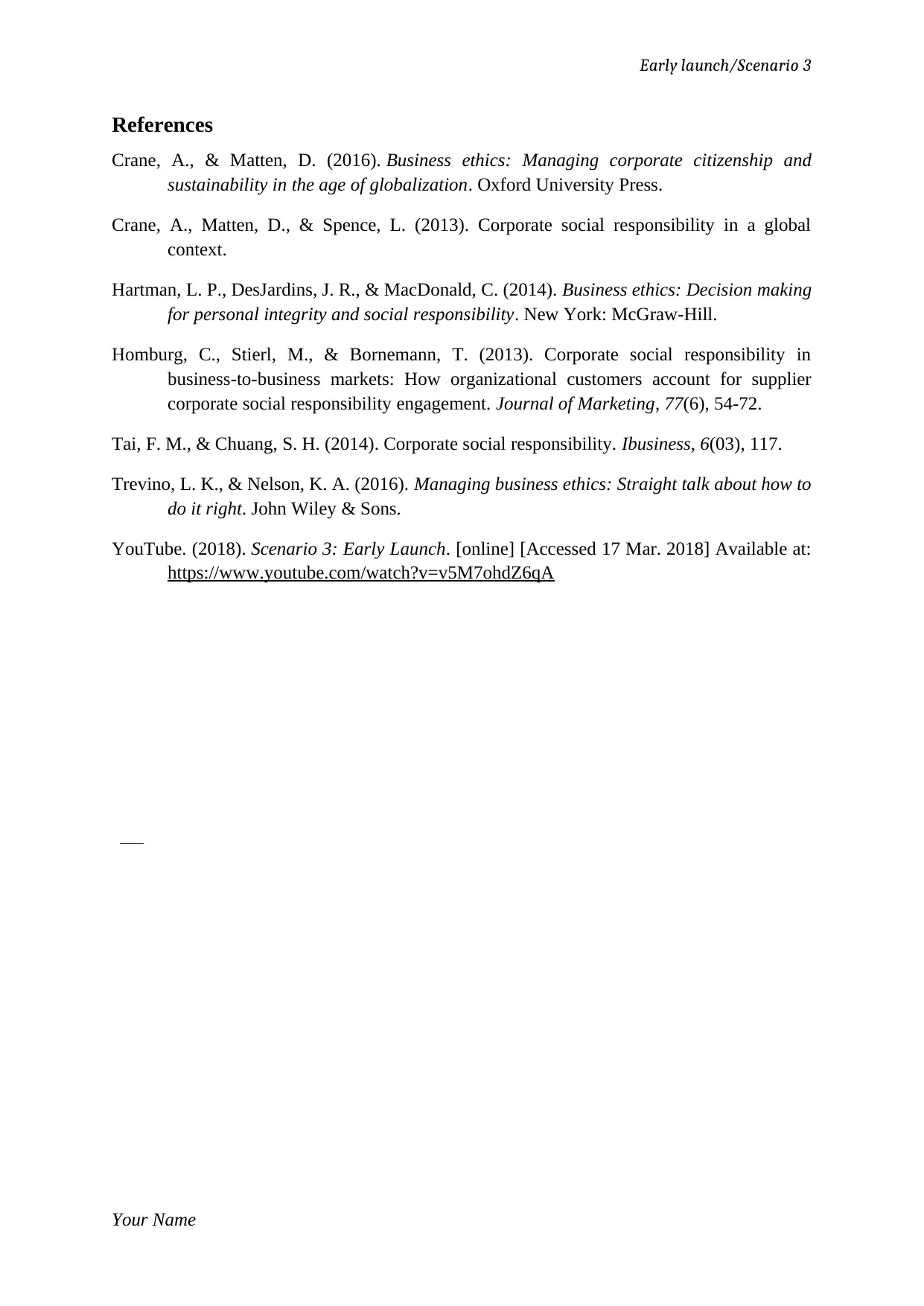
Early launch/Scenario 3
References
Crane, A., & Matten, D. (2016). Business ethics: Managing corporate citizenship and
sustainability in the age of globalization. Oxford University Press.
Crane, A., Matten, D., & Spence, L. (2013). Corporate social responsibility in a global
context.
Hartman, L. P., DesJardins, J. R., & MacDonald, C. (2014). Business ethics: Decision making
for personal integrity and social responsibility. New York: McGraw-Hill.
Homburg, C., Stierl, M., & Bornemann, T. (2013). Corporate social responsibility in
business-to-business markets: How organizational customers account for supplier
corporate social responsibility engagement. Journal of Marketing, 77(6), 54-72.
Tai, F. M., & Chuang, S. H. (2014). Corporate social responsibility. Ibusiness, 6(03), 117.
Trevino, L. K., & Nelson, K. A. (2016). Managing business ethics: Straight talk about how to
do it right. John Wiley & Sons.
YouTube. (2018). Scenario 3: Early Launch. [online] [Accessed 17 Mar. 2018] Available at:
https://www.youtube.com/watch?v=v5M7ohdZ6qA
Your Name
References
Crane, A., & Matten, D. (2016). Business ethics: Managing corporate citizenship and
sustainability in the age of globalization. Oxford University Press.
Crane, A., Matten, D., & Spence, L. (2013). Corporate social responsibility in a global
context.
Hartman, L. P., DesJardins, J. R., & MacDonald, C. (2014). Business ethics: Decision making
for personal integrity and social responsibility. New York: McGraw-Hill.
Homburg, C., Stierl, M., & Bornemann, T. (2013). Corporate social responsibility in
business-to-business markets: How organizational customers account for supplier
corporate social responsibility engagement. Journal of Marketing, 77(6), 54-72.
Tai, F. M., & Chuang, S. H. (2014). Corporate social responsibility. Ibusiness, 6(03), 117.
Trevino, L. K., & Nelson, K. A. (2016). Managing business ethics: Straight talk about how to
do it right. John Wiley & Sons.
YouTube. (2018). Scenario 3: Early Launch. [online] [Accessed 17 Mar. 2018] Available at:
https://www.youtube.com/watch?v=v5M7ohdZ6qA
Your Name
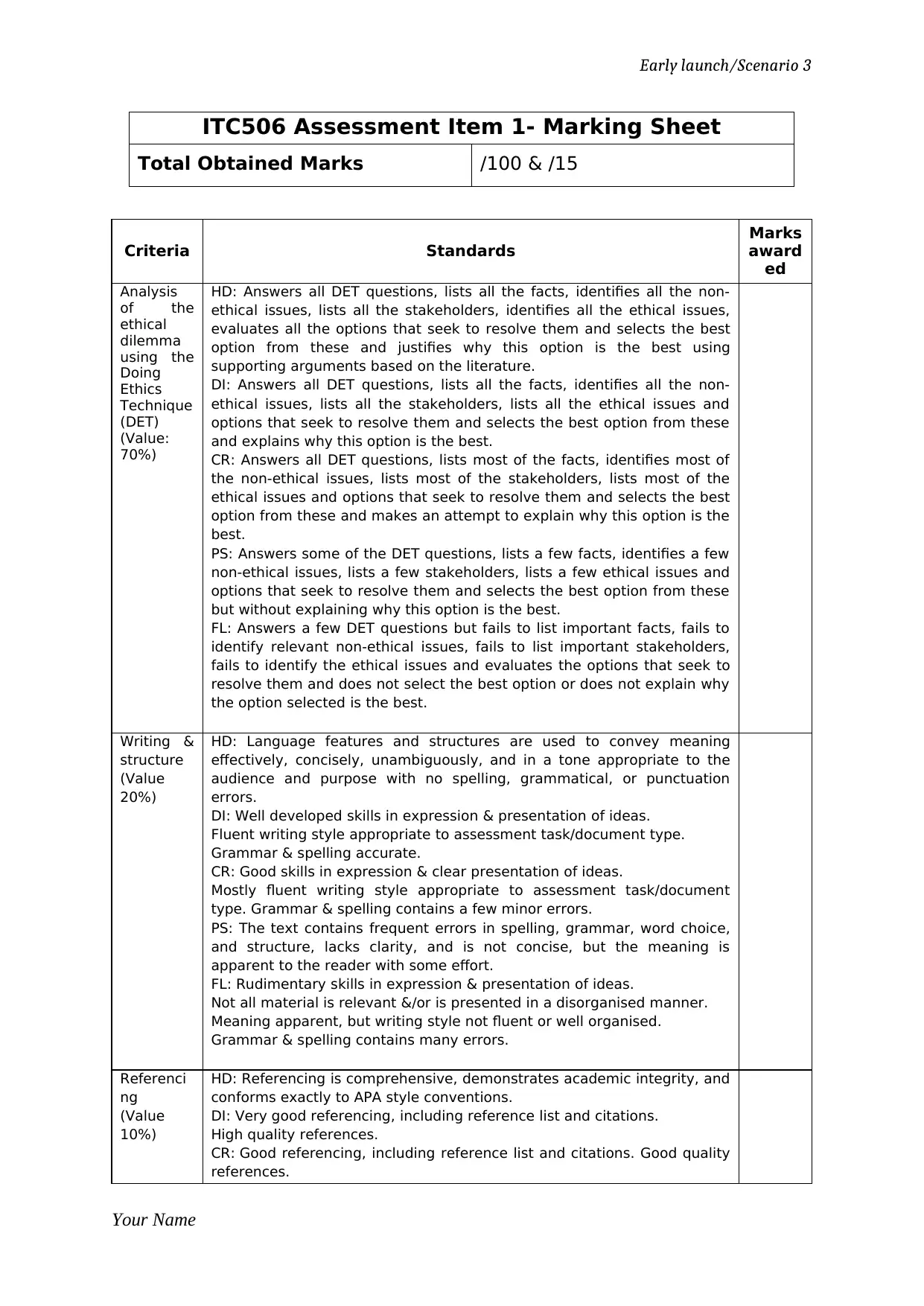
Early launch/Scenario 3
ITC506 Assessment Item 1- Marking Sheet
Total Obtained Marks /100 & /15
Criteria Standards
Marks
award
ed
Analysis
of the
ethical
dilemma
using the
Doing
Ethics
Technique
(DET)
(Value:
70%)
HD: Answers all DET questions, lists all the facts, identifies all the non-
ethical issues, lists all the stakeholders, identifies all the ethical issues,
evaluates all the options that seek to resolve them and selects the best
option from these and justifies why this option is the best using
supporting arguments based on the literature.
DI: Answers all DET questions, lists all the facts, identifies all the non-
ethical issues, lists all the stakeholders, lists all the ethical issues and
options that seek to resolve them and selects the best option from these
and explains why this option is the best.
CR: Answers all DET questions, lists most of the facts, identifies most of
the non-ethical issues, lists most of the stakeholders, lists most of the
ethical issues and options that seek to resolve them and selects the best
option from these and makes an attempt to explain why this option is the
best.
PS: Answers some of the DET questions, lists a few facts, identifies a few
non-ethical issues, lists a few stakeholders, lists a few ethical issues and
options that seek to resolve them and selects the best option from these
but without explaining why this option is the best.
FL: Answers a few DET questions but fails to list important facts, fails to
identify relevant non-ethical issues, fails to list important stakeholders,
fails to identify the ethical issues and evaluates the options that seek to
resolve them and does not select the best option or does not explain why
the option selected is the best.
Writing &
structure
(Value
20%)
HD: Language features and structures are used to convey meaning
effectively, concisely, unambiguously, and in a tone appropriate to the
audience and purpose with no spelling, grammatical, or punctuation
errors.
DI: Well developed skills in expression & presentation of ideas.
Fluent writing style appropriate to assessment task/document type.
Grammar & spelling accurate.
CR: Good skills in expression & clear presentation of ideas.
Mostly fluent writing style appropriate to assessment task/document
type. Grammar & spelling contains a few minor errors.
PS: The text contains frequent errors in spelling, grammar, word choice,
and structure, lacks clarity, and is not concise, but the meaning is
apparent to the reader with some effort.
FL: Rudimentary skills in expression & presentation of ideas.
Not all material is relevant &/or is presented in a disorganised manner.
Meaning apparent, but writing style not fluent or well organised.
Grammar & spelling contains many errors.
Referenci
ng
(Value
10%)
HD: Referencing is comprehensive, demonstrates academic integrity, and
conforms exactly to APA style conventions.
DI: Very good referencing, including reference list and citations.
High quality references.
CR: Good referencing, including reference list and citations. Good quality
references.
Your Name
ITC506 Assessment Item 1- Marking Sheet
Total Obtained Marks /100 & /15
Criteria Standards
Marks
award
ed
Analysis
of the
ethical
dilemma
using the
Doing
Ethics
Technique
(DET)
(Value:
70%)
HD: Answers all DET questions, lists all the facts, identifies all the non-
ethical issues, lists all the stakeholders, identifies all the ethical issues,
evaluates all the options that seek to resolve them and selects the best
option from these and justifies why this option is the best using
supporting arguments based on the literature.
DI: Answers all DET questions, lists all the facts, identifies all the non-
ethical issues, lists all the stakeholders, lists all the ethical issues and
options that seek to resolve them and selects the best option from these
and explains why this option is the best.
CR: Answers all DET questions, lists most of the facts, identifies most of
the non-ethical issues, lists most of the stakeholders, lists most of the
ethical issues and options that seek to resolve them and selects the best
option from these and makes an attempt to explain why this option is the
best.
PS: Answers some of the DET questions, lists a few facts, identifies a few
non-ethical issues, lists a few stakeholders, lists a few ethical issues and
options that seek to resolve them and selects the best option from these
but without explaining why this option is the best.
FL: Answers a few DET questions but fails to list important facts, fails to
identify relevant non-ethical issues, fails to list important stakeholders,
fails to identify the ethical issues and evaluates the options that seek to
resolve them and does not select the best option or does not explain why
the option selected is the best.
Writing &
structure
(Value
20%)
HD: Language features and structures are used to convey meaning
effectively, concisely, unambiguously, and in a tone appropriate to the
audience and purpose with no spelling, grammatical, or punctuation
errors.
DI: Well developed skills in expression & presentation of ideas.
Fluent writing style appropriate to assessment task/document type.
Grammar & spelling accurate.
CR: Good skills in expression & clear presentation of ideas.
Mostly fluent writing style appropriate to assessment task/document
type. Grammar & spelling contains a few minor errors.
PS: The text contains frequent errors in spelling, grammar, word choice,
and structure, lacks clarity, and is not concise, but the meaning is
apparent to the reader with some effort.
FL: Rudimentary skills in expression & presentation of ideas.
Not all material is relevant &/or is presented in a disorganised manner.
Meaning apparent, but writing style not fluent or well organised.
Grammar & spelling contains many errors.
Referenci
ng
(Value
10%)
HD: Referencing is comprehensive, demonstrates academic integrity, and
conforms exactly to APA style conventions.
DI: Very good referencing, including reference list and citations.
High quality references.
CR: Good referencing, including reference list and citations. Good quality
references.
Your Name
⊘ This is a preview!⊘
Do you want full access?
Subscribe today to unlock all pages.

Trusted by 1+ million students worldwide
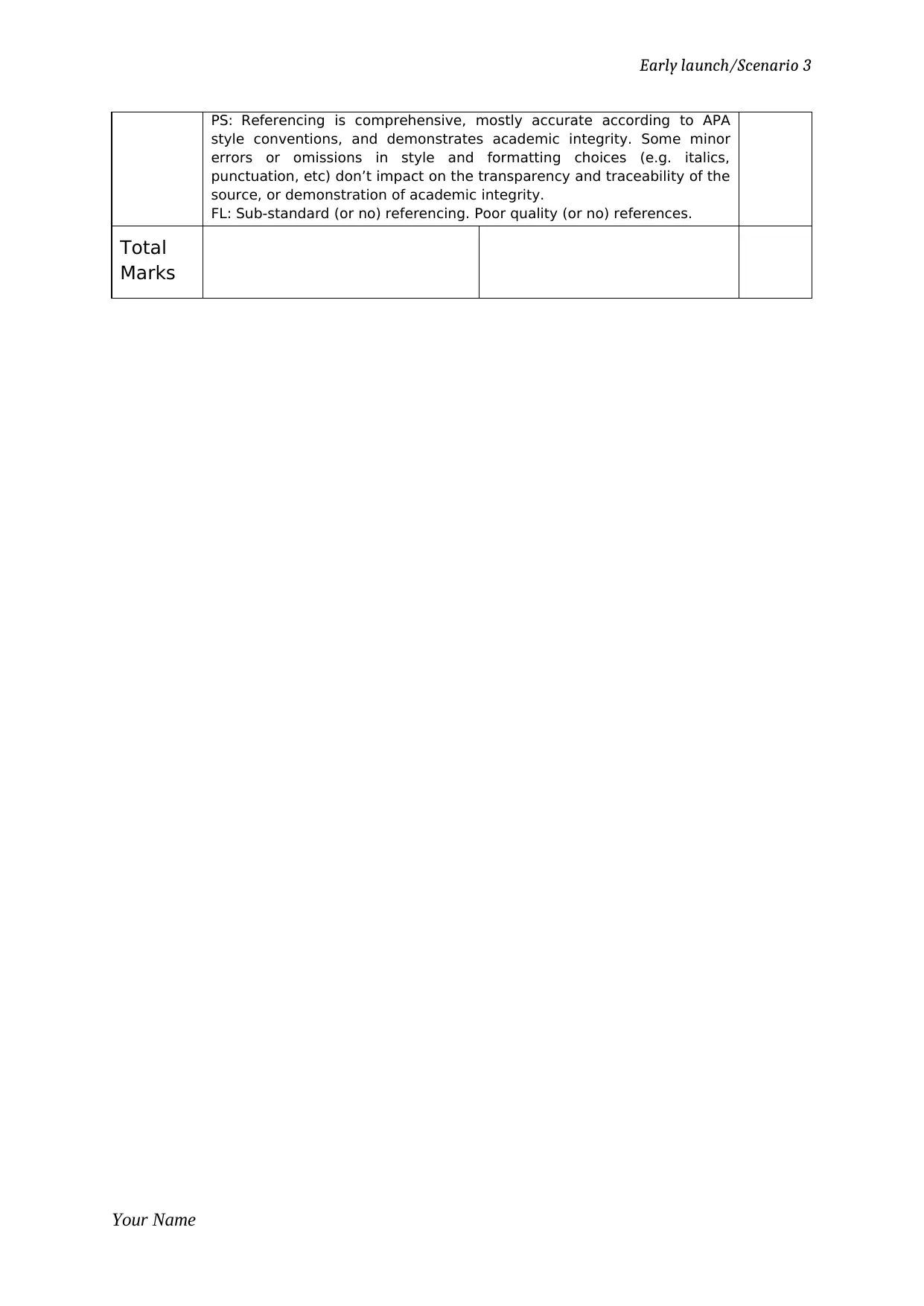
Early launch/Scenario 3
PS: Referencing is comprehensive, mostly accurate according to APA
style conventions, and demonstrates academic integrity. Some minor
errors or omissions in style and formatting choices (e.g. italics,
punctuation, etc) don’t impact on the transparency and traceability of the
source, or demonstration of academic integrity.
FL: Sub-standard (or no) referencing. Poor quality (or no) references.
Total
Marks
Your Name
PS: Referencing is comprehensive, mostly accurate according to APA
style conventions, and demonstrates academic integrity. Some minor
errors or omissions in style and formatting choices (e.g. italics,
punctuation, etc) don’t impact on the transparency and traceability of the
source, or demonstration of academic integrity.
FL: Sub-standard (or no) referencing. Poor quality (or no) references.
Total
Marks
Your Name
1 out of 7
Related Documents
Your All-in-One AI-Powered Toolkit for Academic Success.
+13062052269
info@desklib.com
Available 24*7 on WhatsApp / Email
![[object Object]](/_next/static/media/star-bottom.7253800d.svg)
Unlock your academic potential
Copyright © 2020–2025 A2Z Services. All Rights Reserved. Developed and managed by ZUCOL.





